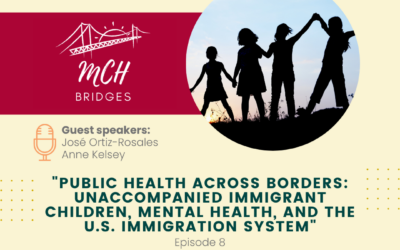AMCHP defines childhood as occurring within 0-11 years of age, and early childhood as occurring during the first five years of life. While outcomes among children are the focus of this section, optimal outcomes cannot be achieved without also being intentional in supporting the well-being of the families and caregivers that surround children as they grow and develop.
Child health includes a variety of focus areas, ranging from environmental health to food access and beyond. To maximize impact and achieve optimal outcomes across child health-related focus areas, AMCHP promotes a collaborative, systems-building, and two-generation approach that centers equitable access to the early childhood system.
Current Initiatives
Program Areas
Early Childhood Systems Building
Title V maternal and child health programs are important partners in promoting equitable and comprehensive early childhood systems. Title V programs can leverage funding, align different program objectives toward common goals, and partner to support critical infrastructure that promotes optimal development. Many opportunities for alignment with Title V exist within the goals of other state- and local-level programs such the Maternal, Infant, and Early Childhood Home Visiting Program (MIECHV), the Early Childhood Comprehensive Systems Program (ECCS), the Child Care Development Fund Program (CCDF), the Preschool Development Grant Program (PDG), Help Me Grow (HMG), Healthy Start, Early Head Start/Head Start programs, Women, Infant and Children program (WIC), and state Medicaid programs. Families with children that have lived experience and context expertise and community-rooted organizations are critical partners in efforts to produce early childhood systems grounded in equitable access and quality of supports. In an effort to model coordinated and aligned partnerships, AMCHP partners with several national-level, early childhood-related resource centers to collaborate on how best to provide technical assistance to our shared audiences in a way that is accessible when, how, and where they want it.
Food Security
Continuous access to culturally appropriate, nutritious foods is essential for promoting the well-being of children and their families/caregivers. When families and caregivers can easily access the foods they want to provide for themselves and their children, they are better able to focus on supporting the children they care for to grow, learn, and develop. Similarly, when children experience continuous access to food, they are better able to grow, learn, and develop.
Systemic racism and the legacy of colonization have created deep injustices in who can and cannot easily access culturally appropriate and nutritious foods, which means that families identifying as Black, Indigenous, Latinx, and/or of Color are more likely to experience unsteady access to food when compared to their White counterparts. Community-rooted organizations and leaders have been organizing to promote more just, sustainable food systems and Title V MCH programs and their partners can lean into and support these community strengths to promote food justice in their states or jurisdictions.
Children & Youth with Special Health Care Needs
Children and youth with special health care needs (CYSHCN) are a diverse group of children and youth that range from children and youth with chronic conditions, to those who are more medically complex, to children and youth with behavioral or emotional conditions. For more information about AMCHP’s role in ensuring CYSHCN receive high quality, family-centered, coordinated health services within an effective system of care, please visit our Children & Youth with Special Health Care Needs page.
Environmental Health
Children are more vulnerable than adults to environmental risks because of biological and behavioral factors. For example, children’s brains and bodies are still developing and thus more vulnerable to toxins. Children proportionately eat, drink, and breathe more than adults which increases their exposures to potentially harmful substances. Common childhood behaviors such as crawling and frequently putting their hands or toys in their mouths also increase their risk of exposure. Environmental exposures before and after birth can have serious physical and/or developmental consequences that can affect children throughout the life course. As such, many state agencies, including Title V programs, have prioritized addressing harmful environmental exposures as it is essential for children to have access to clean air and water as well as healthy living and learning spaces so they can thrive and reach their optimal health.
From 2017-2020, AMCHP led a Maternal and Child Environmental Health Collaborative Improvement and Innovation Network (MCEH CoIIN) to address lead poisoning prevention. Childhood exposure to lead contributes to developmental and intellectual disabilities, higher rates of neurobehavioral disorders such as hyperactivity and attention deficits, and lower birth weight in children. Reducing lead exposure in maternal and child health populations requires a comprehensive, coordinated approach. You can learn more about the MCEH CoIIN and the approaches used by nine different state teams in the MCH Lead Toolkit. For more information about the MCH Lead Toolkit, please visit our current initiatives page.
Title V National Performance Measures
AMCHP supports its members that work on fifteen national performance measures (NPMs) to improve the systems of care for MCH populations. The MCH Block Grant uses these NPMs as part of a three-tiered framework that allows states and jurisdictions to identify priority measures to meet the needs of their state/jurisdiction. Title V programs will track prevalence rates of these NPMs over time to measure impact. There are several different NPMs that are related to child health and AMCHP has created implementation toolkits for each that provide specific evidence-based practices, reports, publications, and resources which can be adapted and implemented:
- NPM 6: Developmental Screening
- NPM 7.1: Injury Hospitalization – Ages 0 through 9
- NPM 8.1: Physical Activity – Ages 6 through 11
- NPM 11: Medical Home
- NPM 13.2: Preventive Dental Visit – Child/Adolescent
- NPM 14.2: Smoking – Household
- NPM 15: Adequate Insurance
To learn more about effective, replicable practices that positively impact child health, visit AMCHP’s Innovation Hub where you can search for practices by population focus, NPM, and several other search criteria.
Children’s Environmental Health Day and National Lead Poisoning Prevention Week | 2023
Children are more likely to experience environmental exposures than adults because of biological and behavioral factors. For example: Children’s brains and bodies are still developing and thus more vulnerable to toxins. Children proportionately eat, drink, and...
A Victory for Immigrant Children and Families: Undoing Recent Harms from the “Public Charge” Rule
By Stacy Collins, MSW, Associate Director, Health Systems Transformation “In keeping with our nation’s values, this policy treats all those we serve with fairness and respect. Though there is still much to do to overcome confusion and fear, we will continue to...
Episode 8 – Public Health Across Borders: Unaccompanied Immigrant Children, Mental Health, and the U.S. Immigration System
Guest Speakers: José Ortiz-Rosales, Deputy Program Director of the Child Advocate Program, the Young Center Anne Kelsey, Policy Analyst for Disability Rights, the Young Center Take a brief break to listen to our latest MCH Bridges podcast episode! This episode...







